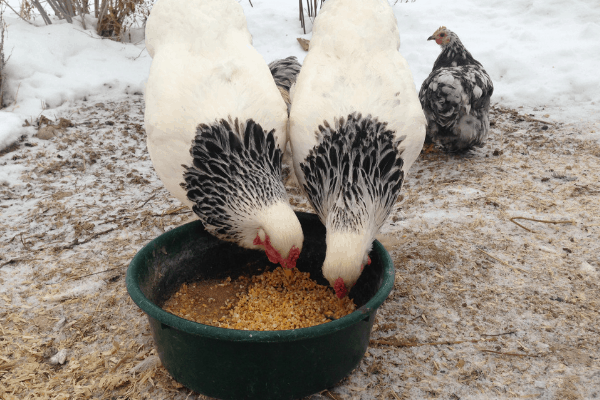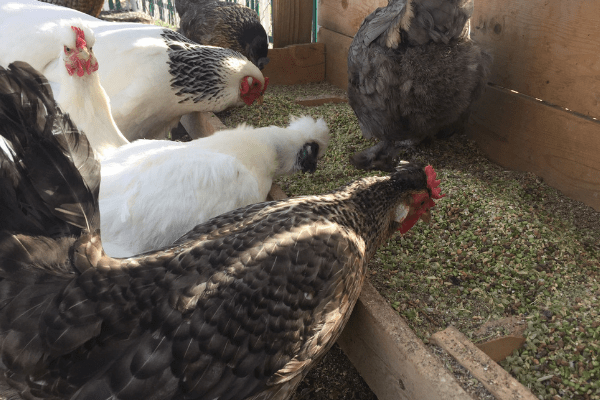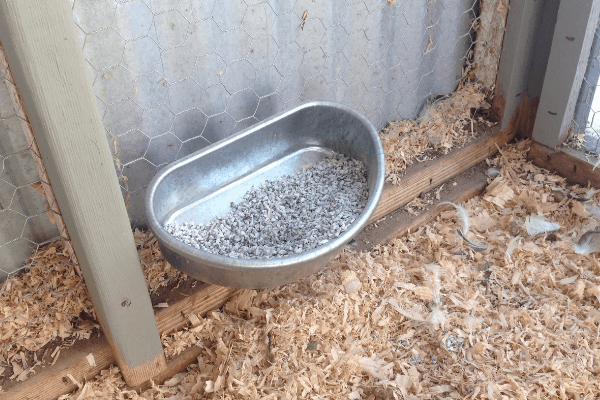An impacted crop is a life-threatening condition that effects chickens. Find out how to recognize an impacted crop and how to help prevent it in your flock!

Two Brahma chickens eating out of food bowl. Photo by author.
Spring is a wonderful time of year! The grass turns green and new growth starts shooting up all around us. While these fresh greens can provide a healthy snack for your chickens, there is a chance that they could cause a serious health concern. Thankfully, proper feeding and flock management can help reduce the risk.
The Crop
A healthy and properly functioning crop is an important part of a chicken’s digestive system. The crop is a specially designed “pouch” created by muscles. When a chicken eats, the food travels down the esophagus to the crop. Since chickens don’t have teeth, they developed other methods for grinding up food. Food in the crop is hydrated by the water the bird drinks. Overnight, food moves through the proventriculus and into the muscular gizzard. The grit that your chickens eat helps to grind food as the gizzard rhythmically contracts. Nutrients from the ground food are absorbed in the small intestine.

Arrow pointing to the crop in a Silkie chicken. Photo by author.
The crop is located on the right side, at the base of the chicken’s throat, just above their chest area. You may notice that, from time to time, it will expand in size. It is normal for this to happen after your chicken eats, but it should return to its normal size once the food passes through. Typically, the crop should be small and unnoticeable in the mornings since the crop empties overnight. A healthy crop will be slightly soft and pliable when you palpate it.
Crop Obstruction
When a crop is blocked, food cannot pass to the gizzard. A common cause of obstruction is the ingestion of foreign bodies that become tangled in the crop. Blockages can also occur when a chicken eats long grasses. There are also certain illnesses that can affect the central nervous system and cause the crop muscles to slow or stop, leading to an obstruction and a drooping crop.
Your chicken may be experiencing a blockage if it has a large or protruding crop that does not decrease in size overnight. Blocked crops will feel hard when you palpate them and chickens that have an obstruction may act dull or listless. They will usually avoid food but increase their water intake. They may also twist their head and neck in an effort to clear the blockage.

chicken eating from a feeding “trough”.
Crop blockages are a potentially fatal condition. You may be able to alleviate minor blocks using at-home methods, but surgery may be required to remove major obstructions. For this reason, it’s wise to take a few preventative measure to help reduce the risk of blocked crops in your flock!
5 Tips to Help Prevent Blocked Crop
1. Remove hazardous debris
Check your chicken coop and chicken run for foreign objects that your chicken might ingest. Common culprits include string, twine, plastic objects, beads and tinsel. When you buy a new bag of feed, be sure to remove and dispose of the strings that are sometimes used to seal feed bags. Check your chicken area regularly for debris – you never know when hazards can blow in with the wind!
2. Help them graze wisely
Do not feed cut grass or hay to chickens, unless if it is finely chopped. When chickens graze in areas with grass, they will generally nip off a small portion of the grass before eating it. However, if cut grass is given to chickens, it increases the likelihood of them swallowing it whole. Longer strands of grass can ball up and create a blockage in the crop.
3. Provide plenty of water
Ensure that your chickens have constant access to fresh water. Water will help move food through the digestive tract and reduce the risk of blockages.

Chicken drinking from waterer. Photo by author.
4. Feed them the best
Provide a high-quality, free choice poultry feed for your chickens. Hunger and nutrition imbalances can create poor foraging habits in chickens. These imbalances increase the risk of eating items that are harmful, which can lead to blockages.
5. Offer grit
When in doubt, provide grit for your chickens. Grit is a small rock-like substance, usually made from flint, that helps chickens grind their food during the digestive process. Provide grit free-choice to chickens that eat any food other than commercial poultry mash (which passes through parts of the digestive tract without having to be broken down much). Grit should be provided for chickens that are given whole grains, fruit, veggies, kitchen scraps or have free-range access. Free-range chickens may not need the grit because they are able to access enough grit-like particles from nature. However, offering grit is never a bad idea, regardless of what your chickens eat!

Grit in a separate tray. Photo by author.
Good feeding habits will help your chickens stay healthy in many ways! But it is also important that chicken keepers are able to recognize and identify medical emergencies, like crop impactions. If you think your chicken may have an impaction, it is always wise to contact a knowledgeable vet or chicken keeper for help.
If one of your birds does develop a blocked crop, here is a video from Cotswolds Chickens to show you one method of carefully clearing the crop.
Kaylee Vaughn is a suburban homesteader, caring for chickens, goats, and a large garden on a little less than an acre. She and her family strive to create the most efficient homestead possible in the small space we have available. Her chickens are not only beautiful yard ornaments, but also a vital part of their homestead management practices! “We utilize them to produce manure, control pests, turn compost, and more.” Kaylee’s nick-named them “the gardeners” because they are always in the garden, working hard – and redecorating on occasion, too! You can follow Kaylee through her website.












